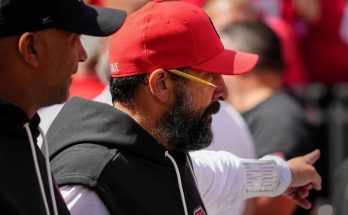Ohio football is not a program that thrives on flash or quick fixes, but rather on the gritty, blue-collar mentality that defines the state itself. That identity is embodied in the coaching staff, particularly in tight ends coach Kyle Obly, who has quickly earned respect across the program for the way he instills toughness, detail, and accountability into his position group. Coming off a defining performance against Rutgers, Obly and his players are now in the spotlight, and the expectation is no longer about potential—it is about consistency and momentum. The Bobcats have long prided themselves on physicality and execution, and the tight ends’ breakout has reinforced the idea that this unit, once an afterthought, could be a central piece of Ohio’s offensive success moving forward.
When a team looks to separate itself in the Mid-American Conference, there are usually two options: out-athlete opponents with speed and explosive playmakers, or build an identity rooted in toughness, discipline, and fundamental football. Ohio has historically leaned toward the latter, and Obly’s coaching philosophy fits perfectly into that vision. Tight ends are often the unsung heroes of any offense, asked to serve as blockers in the trenches, route-runners in the passing game, and versatile chess pieces that can shift momentum in critical moments. For much of the season, the position group had been quiet, doing the dirty work without the recognition, until the matchup against Rutgers changed the conversation. In that game, Ohio’s tight ends made plays that not only extended drives but also shifted momentum and gave the offense an added dimension. Suddenly, what had been a dependable but understated group was thrust into the narrative as a driving force for the Bobcats.
Kyle Obly is not new to the grind. His coaching journey has been marked by persistence, adaptability, and a clear understanding of what it takes to win in college football’s middle tier, where resources aren’t always abundant and development is the lifeblood of the program. For Obly, it’s not about headlines or individual accolades but about teaching players how to compete every day. He emphasizes technique, toughness, and preparation—qualities that may not show up on a stat sheet but reveal themselves in crunch-time moments. Against Rutgers, it was those qualities that showed up, and the results reflected the hard work that had been put in behind the scenes.
What stood out about the Rutgers game wasn’t just the stat line, but the way the tight ends operated with confidence and aggression. They were integral in sealing the edge on outside runs, creating mismatches in the red zone, and giving the quarterback an outlet in high-pressure situations. That kind of versatility doesn’t happen by accident—it is a product of weeks of deliberate coaching and the relentless repetition that Obly demands in practice. Players have spoken about his intensity and his insistence on doing things the right way, even when it means re-running the same drill until it is mastered. That culture of accountability has begun to bear fruit, and with each step forward, the expectation grows.
The Rutgers performance was more than just a breakout; it was a statement that Ohio’s tight ends could be a weapon. In the modern game, where offenses are increasingly spread out and reliant on wide receivers, having a dependable tight end group offers a distinct advantage. They can stretch the field, create mismatches against linebackers and safeties, and add layers to the offensive playbook. More importantly, they embody the grit that Obly himself represents. Every successful team has position coaches who operate like the backbone of the operation, pushing players to go beyond their comfort zones. In many ways, Obly has become that figure for Ohio, turning a group that once flew under the radar into one of the team’s most dependable units.
Momentum is a tricky concept in college football. It is both fragile and contagious. For Ohio, the task now is to build on what was established against Rutgers and carry it through the remainder of the season. One strong performance can inspire confidence, but it is the ability to replicate that standard week after week that separates good teams from great ones. Obly understands that better than anyone, which is why he is quick to temper praise with reminders of the work still to be done. His mantra is simple: consistency is key. It is not enough to shine once; the standard must be to show up every Saturday ready to deliver.
That message resonates with players who know that the MAC grind demands resilience. Unlike programs in power conferences with national media attention and deep recruiting pools, Ohio’s margin for error is razor thin. Every position group must pull its weight, and every breakout moment must serve as a springboard for more. The tight ends have now set a bar for themselves, and with Obly’s leadership, the expectation is they will continue to meet and exceed it. The Bobcats are not built on star power but on the sum of their parts, and the emergence of the tight ends reflects the program’s broader ethos of development and grit.
Part of what makes Obly’s impact so profound is his ability to connect with players on a personal level. Football is as much about relationships as it is about X’s and O’s, and those who thrive as position coaches are the ones who can blend technical teaching with mentorship. Players buy in because they trust him, not just as a coach but as someone who genuinely cares about their growth. That trust becomes fuel on game day, when players are asked to execute with discipline under pressure. It is no coincidence that the tight ends delivered when the spotlight was brightest—they were prepared not only physically but mentally, and that preparation starts in the meeting room with Obly’s leadership.
Looking ahead, Ohio’s offense has an opportunity to redefine itself with the tight ends playing a central role. While the ground game and quarterback play will always be foundational, the ability to deploy tight ends as versatile playmakers adds a dynamic that defenses must account for. It changes how opponents scheme, opening up possibilities across the board. A linebacker forced to respect a tight end in coverage is one less defender focused on the run, and a safety shading toward the seam creates opportunities for receivers outside. These ripple effects can turn the tide of games, and Ohio’s breakout performance against Rutgers offered a glimpse of that potential.
But potential means nothing without follow-through, and that is where Obly’s challenge lies. Sustaining momentum requires constant focus, the ability to learn from mistakes, and the resilience to handle adversity. There will be games when opponents take away certain options, when weather conditions force a shift in game plan, or when execution falters under pressure. In those moments, the standard set by Obly and his group will be tested. How they respond will not only define their season but also the broader narrative of Ohio football’s identity moving forward.
For fans, the excitement is real. Watching a group rise from obscurity to prominence is part of what makes college football so compelling. It isn’t just about the wins and losses—it’s about the stories of growth, the underdog narratives, and the way coaches and players embrace the grind together. Kyle Obly’s tight ends represent that journey, and their success reflects the larger story of Ohio’s commitment to building something sustainable. They may not always make headlines, but their impact is undeniable, and their grit is what keeps the engine running.
As the season progresses, all eyes will be on whether Ohio can turn its Rutgers breakthrough into a foundation for greater success. The schedule will bring challenges, the competition will grow fiercer, and the margin for error will shrink. But if there is one thing that Obly and his players have proven, it is that they are ready for the fight. Built on grit, fueled by preparation, and driven by a coach who refuses to accept anything less than excellence, Ohio’s tight ends are no longer just a supporting cast. They are a symbol of what this program stands for, and their continued momentum could be the key to unlocking Ohio’s full potential.
For those who follow Ohio football, the story is still being written, and the best chapters may lie ahead. The Rutgers breakout was not an endpoint but a beginning, a sign that the grind pays off and that belief in the process can yield tangible results. Fans should watch closely, not just for the touchdowns and highlights but for the moments of toughness, the blocks that spring a big run, and the routes that keep drives alive. That is where the essence of Obly’s coaching shines, and that is where the heart of Ohio football resides.
What do you think—can Ohio’s tight ends sustain their momentum and become the driving force behind the offense for the rest of the season? Do you believe Coach Obly’s grit-driven philosophy can carry them through the toughest stretches of the MAC schedule? Share your thoughts in the comments and join the conversation about the future of this rising unit.



